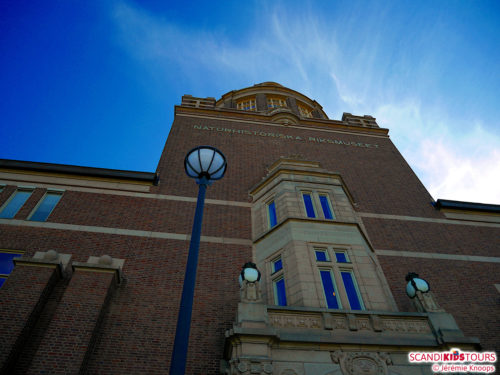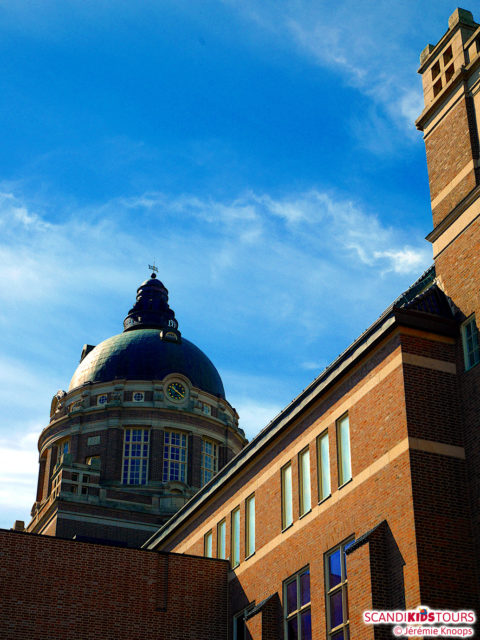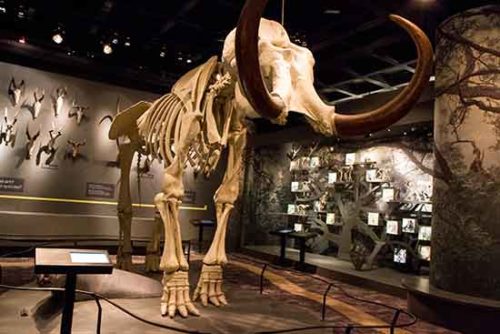Marie-Cerise, 20th august 2020
A whale skeleton, dinosaurs, fossils, stuffed animals, meteorites and precious stones. Can all those things be found in Stockholm? Why, of course! And not far away from the city centre, what’s more! The Swedish Museum of Natural History (Naturhistoriska riksmuseet) is located close to Stockholm University. Young and old alike, it’s time to go on a little adventure inside Sweden’s largest museum. Bring your family for an educational and interactive visit in a world where animals, stones and plants meet like nowhere else.
Once upon a Time … Natural History
The story of the Swedish Museum of Natural History goes back to the 18th century. The Royal Swedish Academy of Sciences was founded at the beginning of that century. Today, this institution is best known for selecting the laureates for the Nobel Prize in Chemistry, in Physics and in Economic Sciences.

Shortly after the Academy was founded the scientists received many items to study. Those donations were the starting point of the museum we know today. With time the collections took more and more space and the scientists had to move them quite often from one building to another. Hence the need for a new house to harbour the collections of the Royal Swedish Academy of Sciences and the decision to build a new museum, taken in 1901. Construction works began in 1907 under the tutelage of the architect chosen for such a huge project, Axel Anderberg. He had indeed just finished two famous buildings in the centre of Stockholm: the new Royal Swedish Opera House, a stones’ throw from the old town, and the Oscar Theatre (Oscarsteatern) on the broad avenue Kungsgatan. It took a total of nine years to build the new museum which eventually opened its doors to the public in 1916.
The Building’s Architecture
This magnificent building is topped with a dome in order to let the light in. Since electricity was not available everywhere at the beginning of the 20th century the museum was simply lit by natural daylight. In 2013 when the museum was renovated workers took great care when it came to cleaning the dome. They used ancient (quite singular!) methods, meaning that toothbrushes and cotton buds were needed indeed in order to give a new lease of life to the dome.

Permanent Exhibitions
The Natural History Museum is Sweden’s largest museum with more than 11 million items in its collections. When it opened its doors in 1916 three collections were exhibited in the main building: the geological, the zoological and the palaeontological ones. The botanical department was also on display, but the botanists wanted to have a private building next to the main one. Written out in the upper angle of the main door of that building – empty today, for it is to be renovated – you will still find the inscription botaniskt museum, or simply museum of botany.

Today the Swedish Museum of Natural History totals 10 permanent exhibitions, each more captivating and more educational than the other.So, to young and old alike: let’s discover fossils, life in water, polar regions, Swedish nature, treasures from the Earth’s interior and many more.Find your way through the exhibitions by using the audio-guide on your smartphone (it is as simple as that!) and listen to the 11 audio-tracks (including an introductory one). Rest assured, you don’t have to follow the order to the letter; pick the exhibitions you are most interested in and explore the world and its mysteries with your family. Don’t skip the exhibition “Life in Sweden” though and make sure you install its Augmented Reality App to discover Swedish animals from another perspective. The application is called Nya Djur ! (“New animals!”) and can be downloaded for free on the App store or on Google Play. The children will like it, no doubt!
Cosmonova, a cinematographic Adventure
In addition to the permanent exhibitions, the Natural History Museum houses a dome theatre called the Cosmonova. Once inside, young and old alike will start an unforgettable and exciting cinematographic adventure: you will experience our amazing planet from space, follow the turtles for a memorable journey in the ocean, among many other breath-taking expeditions. The theatre dome is 23 meters in diameter and can host up to 262 spectators who will be delighted by the IMAX®films, projected on a 760m2 -screen.
*Please note that the Cosmonova will remain closed until further notice due to the current situation with Covid-19.
Visiting the Museum in Corona Time
(live or online)
In these rather peculiar circumstances everything has to be adapted in order to ensure everybody’s safety. On June 22nd, the museum opened up selected exhibitions for a limited number of visitors so as not to have too many at the same time. A pre-booked online free ticket is required to access the rooms. Each day 3 groups of 40 people are welcome to spend 2 hours in the museum, which is always thoroughly cleaned and disinfected before the arrival of its next visitors.
If you don’t find the opportunity to travel to Stockholm, you can still visit the museum online (https://upplevmuseet.nrm.se/). This virtual and interactive tour will make you travel in the heart of the museum in search of the most astonishing items of its collections such as the calf with two heads or the juvenile blue whale skeleton. Short videos will ensure that the whole family can learn about the different animals and that you don’t miss the museum’s greatest treasures. If after your virtual tour you still struggle with questions regarding stones, plants or animals, the researchers of the museum will be pleased to answer your queries. Don’t let these disturb your night rest and feel free to reach out and contact them using the online form!

The summer of 2020 is not like any others, but the museum’s guides have prepared guided tours in Swedish around the museum. Now is your chance to learn more about the surroundings of the museum. Where do this big pearl and those fossils come from? What’s the job of the researchers? What kind of trees are planted around the museum? You will also get a chance to explore the outside collections and see a 22-ton iron block and a butterfly-hostel. If you don’t feel like following a guided tour in Swedish, just contact Scandikidstours to get your family a personalised visit of the Swedish Museum of Natural History and its surroundings. Looking forward to seeing you in Stockholm!
Marie-Cerise, 20th august 2020
Source and inspiration : https://www.nrm.se/
Photos : Jérémie Knoops

